2023 TOYOTA 86 ECO mode
[x] Cancel search: ECO modePage 310 of 449
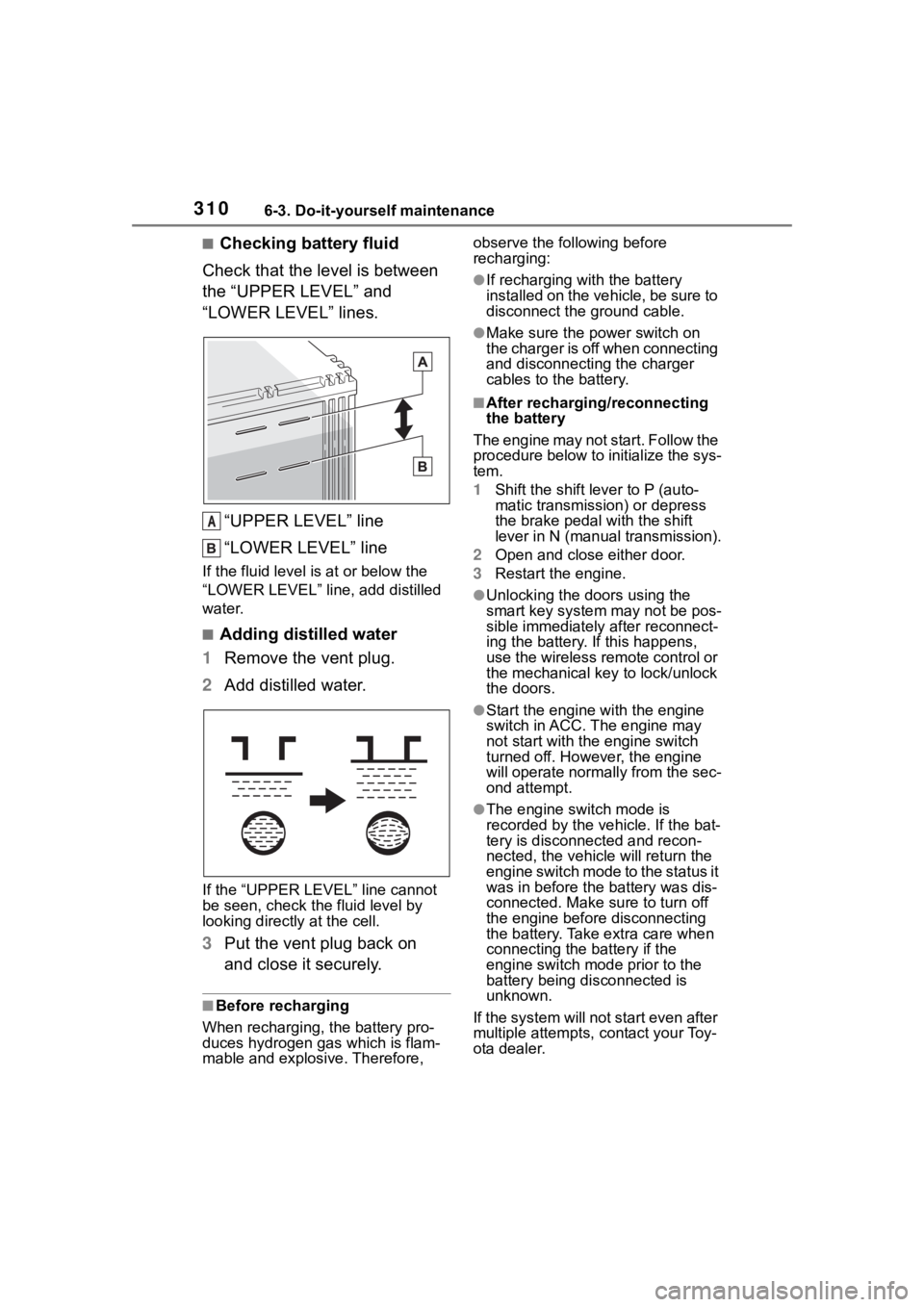
3106-3. Do-it-yourself maintenance
■Checking battery fluid
Check that the level is between
the “UPPER LEVEL” and
“LOWER LEVEL” lines.
“UPPER LEVEL” line
“LOWER LEVEL” line
If the fluid level is at or below the
“LOWER LEVEL” line, add distilled
water.
■Adding distilled water
1 Remove the vent plug.
2 Add distilled water.
If the “UPPER LEVEL ” line cannot
be seen, check the fluid level by
looking directly at the cell.
3 Put the vent plug back on
and close it securely.
■Before recharging
When recharging, t he battery pro-
duces hydrogen ga s which is flam-
mable and explosive. Therefore, observe the following before
recharging:
●If recharging with the battery
installed on the vehicle, be sure to
disconnect the ground cable.
●Make sure the power switch on
the charger is off when connecting
and disconnecting the charger
cables to the battery.
■After recharging/reconnecting
the battery
The engine may not start. Follow the
procedure below to initialize the sys-
tem.
1 Shift the shift lever to P (auto-
matic transmission) or depress
the brake pedal with the shift
lever in N (manual transmission).
2 Open and close either door.
3 Restart the engine.
●Unlocking the doors using the
smart key system may not be pos-
sible immediately after reconnect-
ing the battery. If this happens,
use the wireless remote control or
the mechanical key to lock/unlock
the doors.
●Start the engine with the engine
switch in ACC. T he engine may
not start with th e engine switch
turned off. However, the engine
will operate normally from the sec-
ond attempt.
●The engine switch mode is
recorded by the vehicle. If the bat-
tery is disconnected and recon-
nected, the vehi cle will return the
engine switch mode to the status it
was in before the battery was dis-
connected. Make sure to turn off
the engine before disconnecting
the battery. Take extra care when
connecting the battery if the
engine switch mode prior to the
battery being disconnected is
unknown.
If the system will not start even after
multiple attempts, contact your Toy-
ota dealer.
A
Page 371 of 449
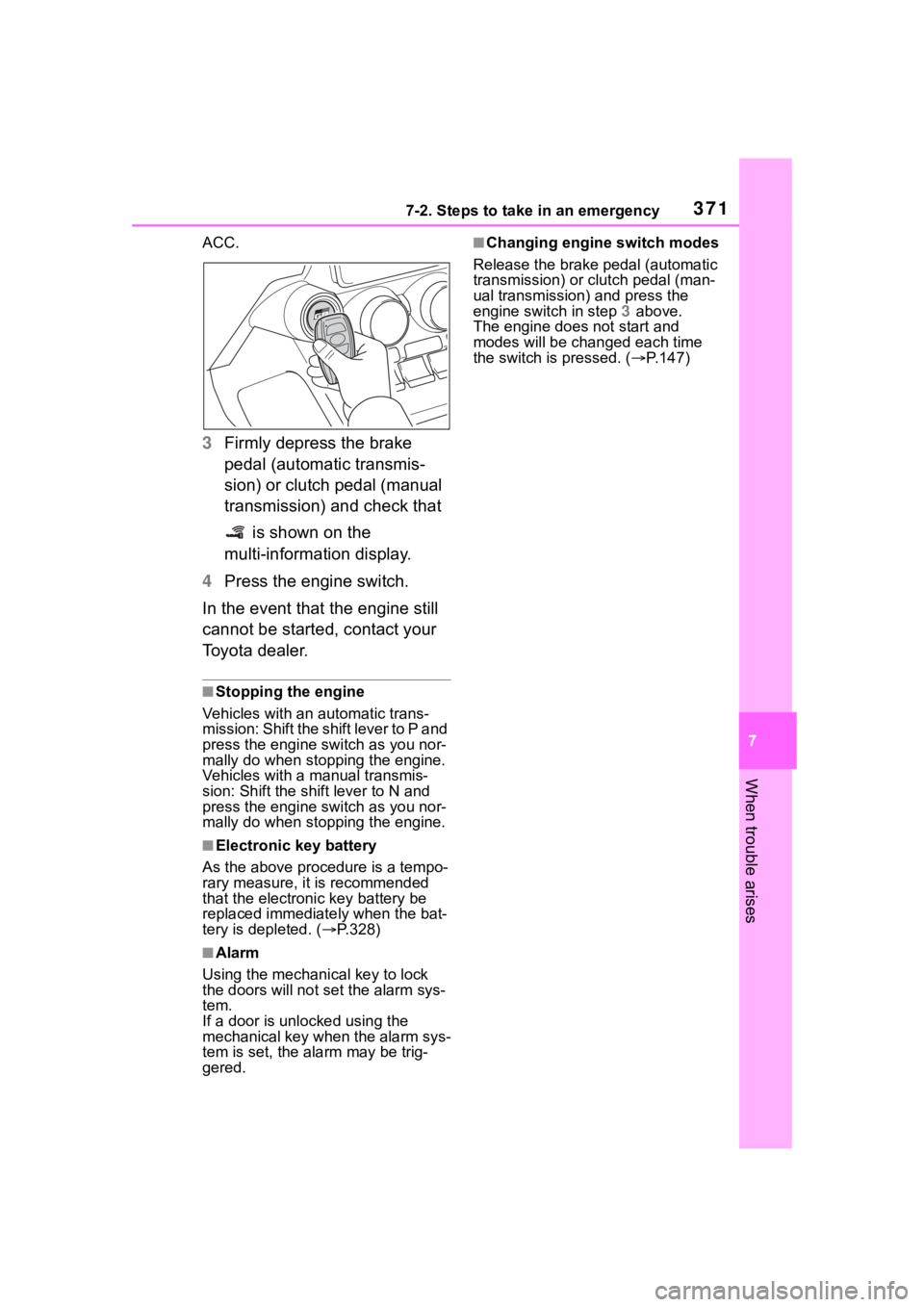
3717-2. Steps to take in an emergency
7
When trouble arises
ACC.
3Firmly depress the brake
pedal (automatic transmis-
sion) or clutch pedal (manual
transmission) and check that
is shown on the
multi-information display.
4 Press the engine switch.
In the event that the engine still
cannot be started, contact your
Toyota dealer.
■Stopping the engine
Vehicles with an automatic trans-
mission: Shift the shift lever to P and
press the engine switch as you nor-
mally do when stopping the engine.
Vehicles with a manual transmis-
sion: Shift the shift lever to N and
press the engine switch as you nor-
mally do when stopping the engine.
■Electronic key battery
As the above proc edure is a tempo-
rary measure, it is recommended
that the electronic key battery be
replaced immediate ly when the bat-
tery is depleted. ( P.328)
■Alarm
Using the mechanical key to lock
the doors will not set the alarm sys-
tem.
If a door is unlocked using the
mechanical key when the alarm sys-
tem is set, the alarm may be trig-
gered.
■Changing engine switch modes
Release the brake pedal (automatic
transmission) or clutch pedal (man-
ual transmission) and press the
engine switch in step 3 above.
The engine does not start and
modes will be changed each time
the switch is pressed. ( P.147)
Page 373 of 449
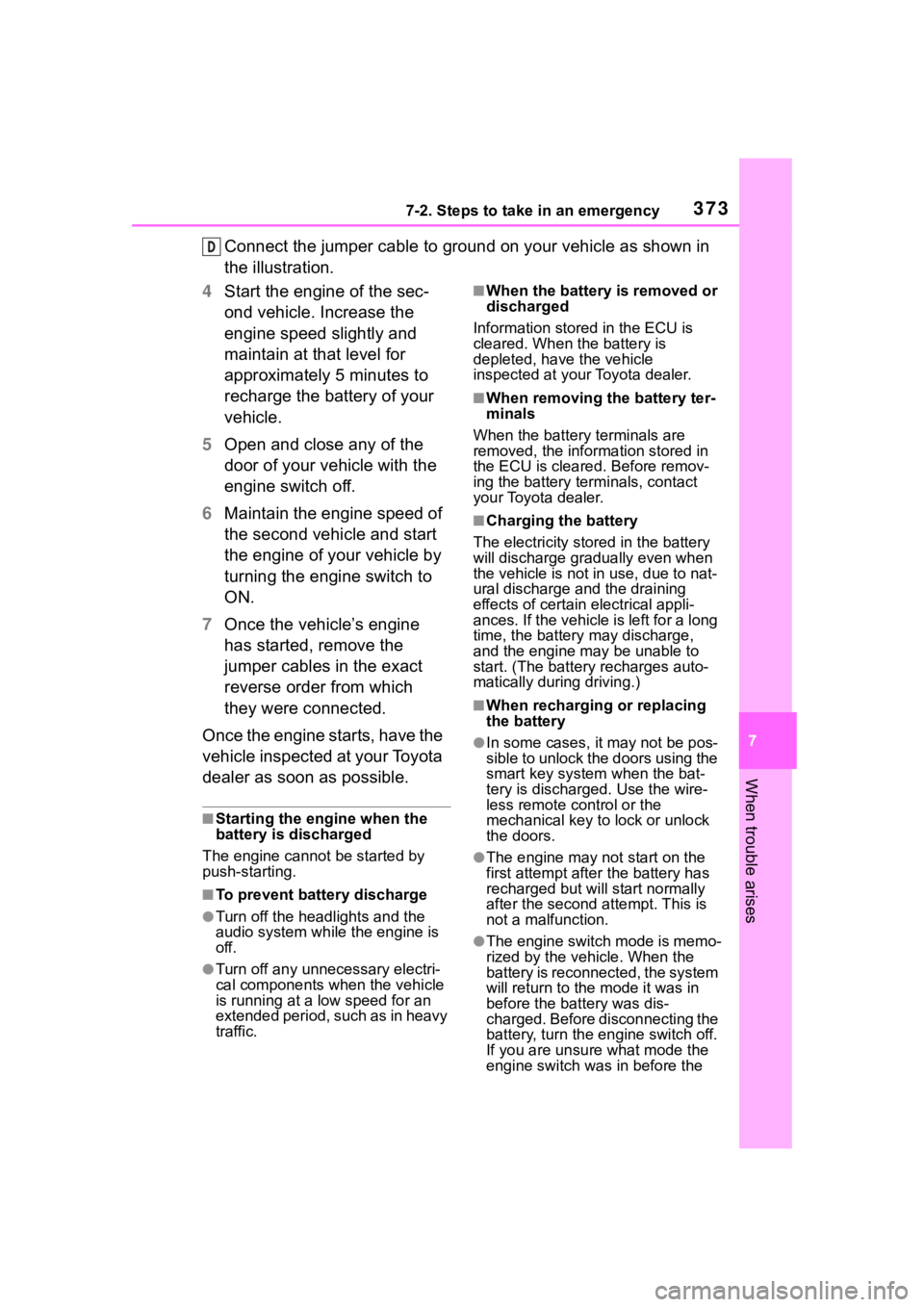
3737-2. Steps to take in an emergency
7
When trouble arises
Connect the jumper cable to ground on your vehicle as shown in
the illustration.
4 Start the engine of the sec-
ond vehicle. Increase the
engine speed slightly and
maintain at that level for
approximately 5 minutes to
recharge the battery of your
vehicle.
5 Open and close any of the
door of your vehicle with the
engine switch off.
6 Maintain the engine speed of
the second vehicle and start
the engine of your vehicle by
turning the engine switch to
ON.
7 Once the vehicle’s engine
has started, remove the
jumper cables in the exact
reverse order from which
they were connected.
Once the engine starts, have the
vehicle inspected at your Toyota
dealer as soon as possible.
■Starting the engine when the
battery is discharged
The engine cannot be started by
push-starting.
■To prevent battery discharge
●Turn off the headlights and the
audio system while the engine is
off.
●Turn off any unnecessary electri-
cal components when the vehicle
is running at a low speed for an
extended period, such as in heavy
traffic.
■When the battery is removed or
discharged
Information stored in the ECU is
cleared. When the battery is
depleted, have the vehicle
inspected at your Toyota dealer.
■When removing the battery ter-
minals
When the battery terminals are
removed, the information stored in
the ECU is cleared. Before remov-
ing the battery term inals, contact
your Toyota dealer.
■Charging the battery
The electricity stored in the battery
will discharge grad ually even when
the vehicle is not in use, due to nat-
ural discharge and the draining
effects of certain electrical appli-
ances. If the vehicle is left for a long
time, the battery may discharge,
and the engine may be unable to
start. (The battery recharges auto-
matically during driving.)
■When recharging or replacing
the battery
●In some cases, it may not be pos-
sible to unlock the doors using the
smart key system when the bat-
tery is discharged. Use the wire-
less remote control or the
mechanical key to lock or unlock
the doors.
●The engine may not start on the
first attempt after the battery has
recharged but will start normally
after the second attempt. This is
not a malfunction.
●The engine switch mode is memo-
rized by the vehicle. When the
battery is reconnected, the system
will return to the mode it was in
before the bat tery was dis-
charged. Before disconnecting the
battery, turn the engine switch off.
If you are unsure what mode the
engine switch wa s in before the
D
Page 420 of 449
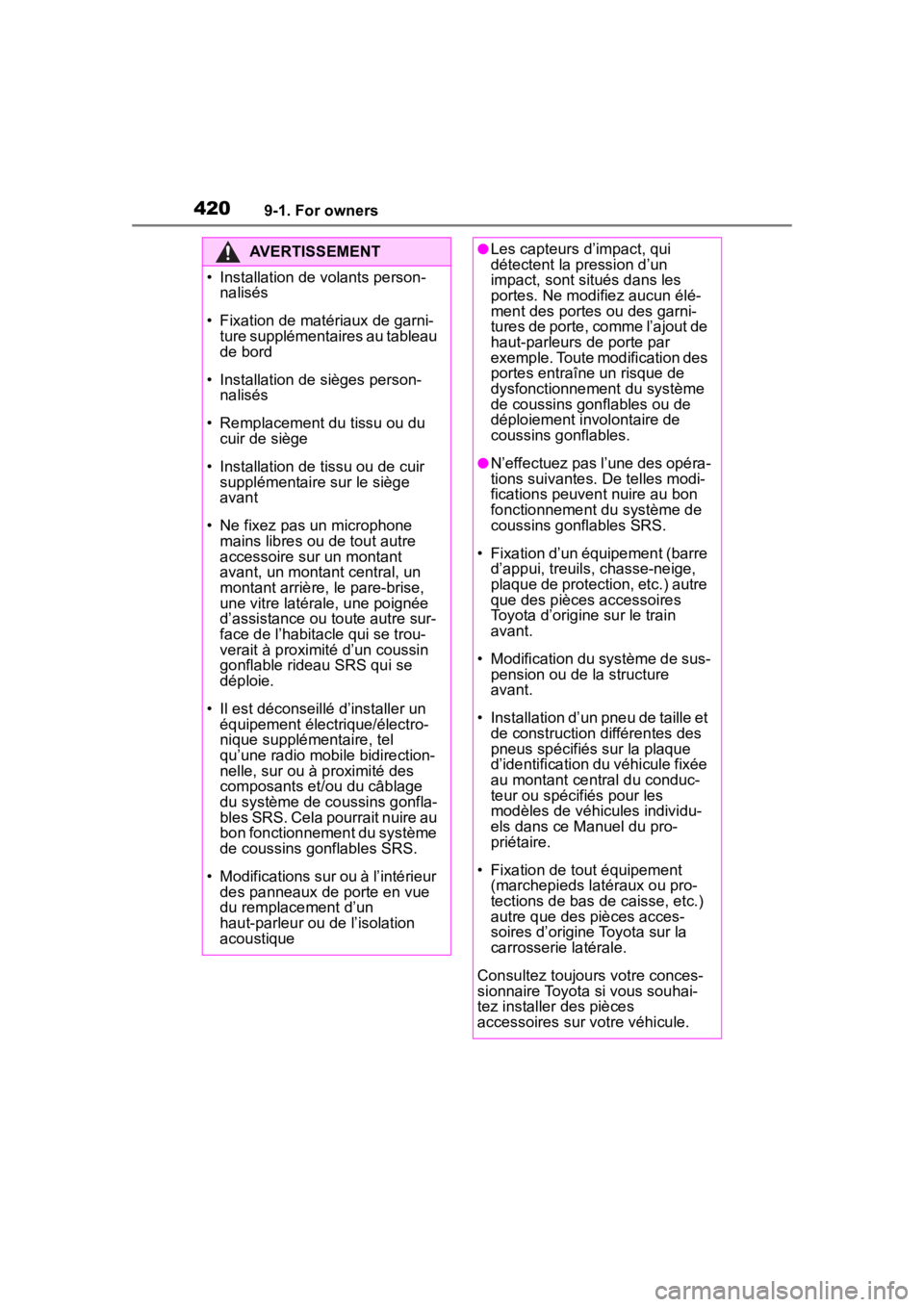
4209-1. For owners
AVERTISSEMENT
• Installation de volants person-nalisés
• Fixation de matériaux de garni- ture supplémentaires au tableau
de bord
• Installation de sièges person- nalisés
• Remplacement du tissu ou du cuir de siège
• Installation de tissu ou de cuir supplémentaire sur le siège
avant
• Ne fixez pas un microphone mains libres ou de tout autre
accessoire sur un montant
avant, un montan t central, un
montant arrière, le pare-brise,
une vitre latérale, une poignée
d’assistance ou toute autre sur-
face de l’habitacle qui se trou-
verait à proximité d’un coussin
gonflable rideau SRS qui se
déploie.
• Il est déconseillé d’installer un équipement électrique/électro-
nique supplémentaire, tel
qu’une radio mobile bidirection-
nelle, sur ou à proximité des
composants et/ou du câblage
du système de coussins gonfla-
bles SRS. Cela pourrait nuire au
bon fonctionnement du système
de coussins gonflables SRS.
• Modifications sur ou à l’intérieur des panneaux de porte en vue
du remplacement d’un
haut-parleur ou de l’isolation
acoustique
●Les capteurs d’impact, qui
détectent la pression d’un
impact, sont situés dans les
portes. Ne modifiez aucun élé-
ment des portes ou des garni-
tures de porte, comme l’ajout de
haut-parleurs de porte par
exemple. Toute modification des
portes entraîne un risque de
dysfonctionnement du système
de coussins gonflables ou de
déploiement involontaire de
coussins gonflables.
●N’effectuez pas l’une des opéra-
tions suivantes. De telles modi-
fications peuvent nuire au bon
fonctionnement du système de
coussins gonflables SRS.
• Fixation d’un équipement (barre d’appui, treuils, chasse-neige,
plaque de protection, etc.) autre
que des pièces accessoires
Toyota d’origine sur le train
avant.
• Modification du système de sus- pension ou de la structure
avant.
• Installation d’un pneu de taille et de construction différentes des
pneus spécifiés sur la plaque
d’identification du véhicule fixée
au montant central du conduc-
teur ou spécifiés pour les
modèles de véhicules individu-
els dans ce Manuel du pro-
priétaire.
• Fixation de tout équipement (marchepieds latéraux ou pro-
tections de bas de caisse, etc.)
autre que des pièces acces-
soires d’origine Toyota sur la
carrosserie latérale.
Consultez toujours votre conces-
sionnaire Toyota si vous souhai-
tez installer des pièces
accessoires sur votre véhicule.
Page 430 of 449
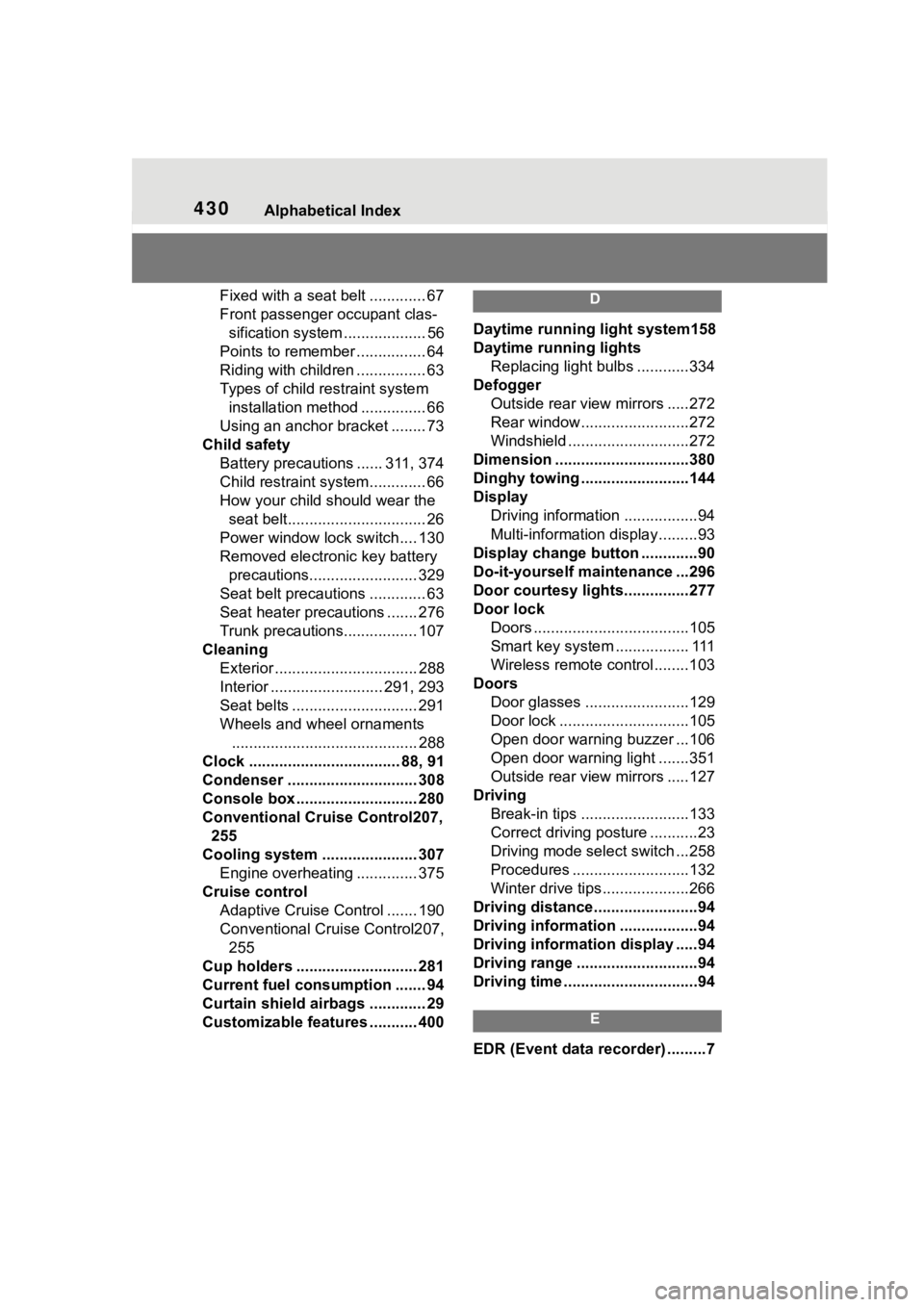
430Alphabetical Index
Fixed with a seat belt ............. 67
Front passenger occupant clas-sification system ................... 56
Points to remember ................ 64
Riding with children ................ 63
Types of child restraint system installation met hod ............... 66
Using an anchor bracket ........ 73
Child safety Battery precautions ...... 311, 374
Child restraint system............. 66
How your child should wear the seat belt................................ 26
Power window lock switch.... 130
Removed electronic key battery precautions......................... 329
Seat belt precautions ............. 63
Seat heater precautions ....... 276
Trunk precautions................. 107
Cleaning Exterior ................................. 288
Interior .......................... 291, 293
Seat belts ............................. 291
Wheels and wheel ornaments........................................... 288
Clock ................................... 88, 91
Condenser .............................. 308
Console box ............................ 280
Conventional Cruise Control207, 255
Cooling system ...................... 307 Engine overheating .............. 375
Cruise control Adaptive Cruise Control ....... 190
Conventional Cruise Control207, 255
Cup holders ............................ 281
Current fuel consumption ....... 94
Curtain shield airbags ............. 29
Customizable features ........... 400D
Daytime running light system158
Daytime running lights Replacing light bulbs ............334
Defogger Outside rear view mirrors .....272
Rear window.........................272
Windshield ............................272
Dimension ...............................380
Dinghy towing .........................144
Display Driving information .................94
Multi-information display.........93
Display change button .............90
Do-it-yourself maintenance ...296
Door courtesy lights...............277
Door lock Doors ....................................105
Smart key system ................. 111
Wireless remote control........103
Doors Door glasses ........................129
Door lock ..............................105
Open door warning buzzer ...106
Open door warning light .......351
Outside rear view mirrors .....127
Driving Break-in tips .........................133
Correct driving posture ...........23
Driving mode select switch ...258
Procedures ...........................132
Winter drive tips....................266
Driving distance........................94
Driving information ..................94
Driving information display .....94
Driving range ............................94
Driving time ...............................94
E
EDR (Event data recorder) .........7
Page 431 of 449

431Alphabetical Index
Electric Power Steering (EPS)............................................... 262Warning light ........................ 350
Electronic key ......................... 102 Battery-saving fun ction......... 112
If the electronic key does not operate properly ................. 370
Replacing the battery ........... 328
Emergency flashers ............... 338
Emergency tire puncture ....... 358
Emergency, in case of If a warning buzzer sounds .. 348
If a warning light turns on ..... 348
If a warning message is dis-played................................. 357
If the battery is discharged ... 372
If the electronic key does not operate properly ................. 370
If the engin e will not start ..... 367
If the fuel filler door cannot be opened ............................... 369
If the vehicle is submerged or water on the road is rising .. 339
If you have a flat tire ............. 358
If you lose your keys ............ 369
If you think something is wrong ........................................... 346
If your vehicle becomes stuck ........................................... 377
If your vehicle has to be stopped in an emergency................. 338
If your vehicle needs to be towed ........................................... 341
If your vehicle overheats ...... 375
Engine ACCESSORY mode ............. 147
Compartment ....................... 305
Engine switch ....................... 145
Fuel pump shut off system ... 347
Hood..................................... 302
How to start the engine ........ 145
Identification number ............ 381 If the engine will not start......367
If your vehicle has to be stopped
in an emergency .................338
Ignition switch (engine switch) ...........................................145
Overheating ..........................375
Tachometer.............................88
Engine coolant Capacity ...............................383
Checking ..............................307
Preparing and checking before winter ..................................266
Engine coolant temperature gauge .......................................88
Engine immobilizer system .....80
Engine oil Capacity ...............................382
Checking ..............................305
Preparing and checking before winter ..................................266
Warning light.........................349
Engine oil temperature gauge .94
Engine switch .........................145 Auto power off fun ction .........148
Changing the engine switch modes.................................147
If your vehicle has to be stopped in an emergency .................338
EPS (Electric Po wer Steering)
...............................................262 Warning light.........................350
Event data recorder (EDR) .........7
EyeSight ..................................170 Adaptive Cruise Control .......190
Conventional Cruise Control 207
Lane Departure Warning ......220
Lane Sway Warning .............222
Lead Vehicle Start Alert ........224
Malfunction ...........................228
Pre-Collision Braking System...........................................179
Page 436 of 449
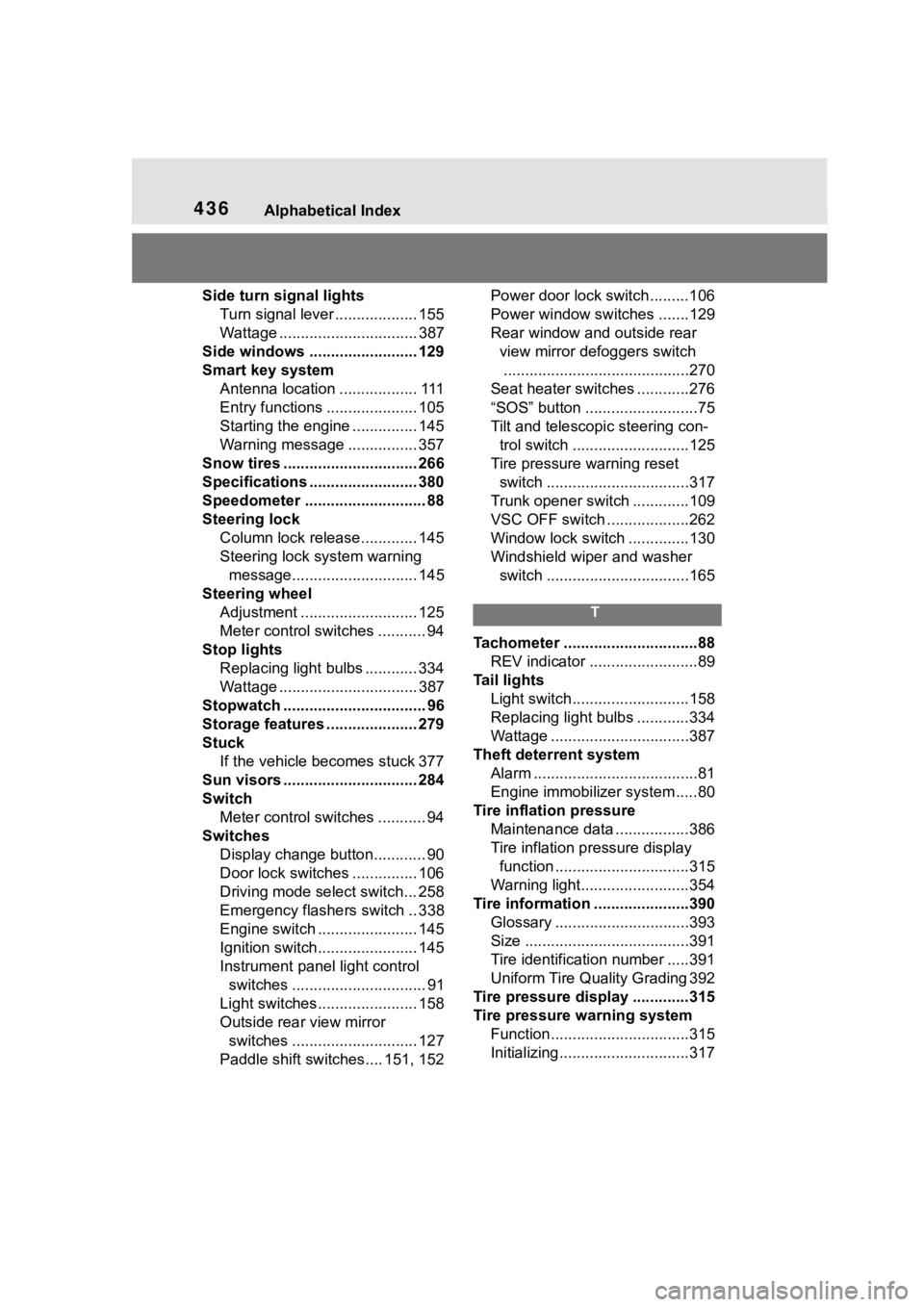
436Alphabetical Index
Side turn signal lightsTurn signal lever ................... 155
Wattage ................................ 387
Side windows ...... ................... 129
Smart key system Antenna location .................. 111
Entry functions ..................... 105
Starting the engine ............... 145
Warning message ................ 357
Snow tires ............................... 266
Specifications ......................... 380
Speedometer ............................ 88
Steering lock Column lock release............. 145
Steering lock system warning message............................. 145
Steering wheel Adjustment ........................... 125
Meter control switches ........... 94
Stop lights Replacing light bulbs ............ 334
Wattage ................................ 387
Stopwatch ................................. 96
Storage features ..................... 279
Stuck If the vehicle becomes stuck 377
Sun visors ............................... 284
Switch Meter control switches ........... 94
Switches Display change button............ 90
Door lock switches ............... 106
Driving mode select switch... 258
Emergency flashers switch .. 338
Engine switch ....................... 145
Ignition switch....................... 145
Instrument panel light control switches ............................... 91
Light switches....................... 158
Outside rear view mirror switches ............................. 127
Paddle shift switches.... 151, 152 Power door lock switch.........106
Power window switches .......129
Rear window and outside rear
view mirror defoggers switch...........................................270
Seat heater switches ............276
“SOS” button ..........................75
Tilt and telescopic steering con- trol switch ...........................125
Tire pressure warning reset switch .................................317
Trunk opener switch .............109
VSC OFF switch ...................262
Window lock switch ..............130
Windshield wiper and washer switch .................................165
T
Tachometer ...............................88 REV indicator .........................89
Tail lights Light switch...........................158
Replacing light bulbs ............334
Wattage ................................387
Theft deterrent system Alarm ......................................81
Engine immobilizer system .....80
Tire inflation pressure Maintenance data .................386
Tire inflation pressure display function ...............................315
Warning light.........................354
Tire information ......................390 Glossary ...............................393
Size ......................................391
Tire identification number .....391
Uniform Tire Quality Grading 392
Tire pressure display .............315
Tire pressure warning system Function................................315
Initializing..............................317
Page 437 of 449
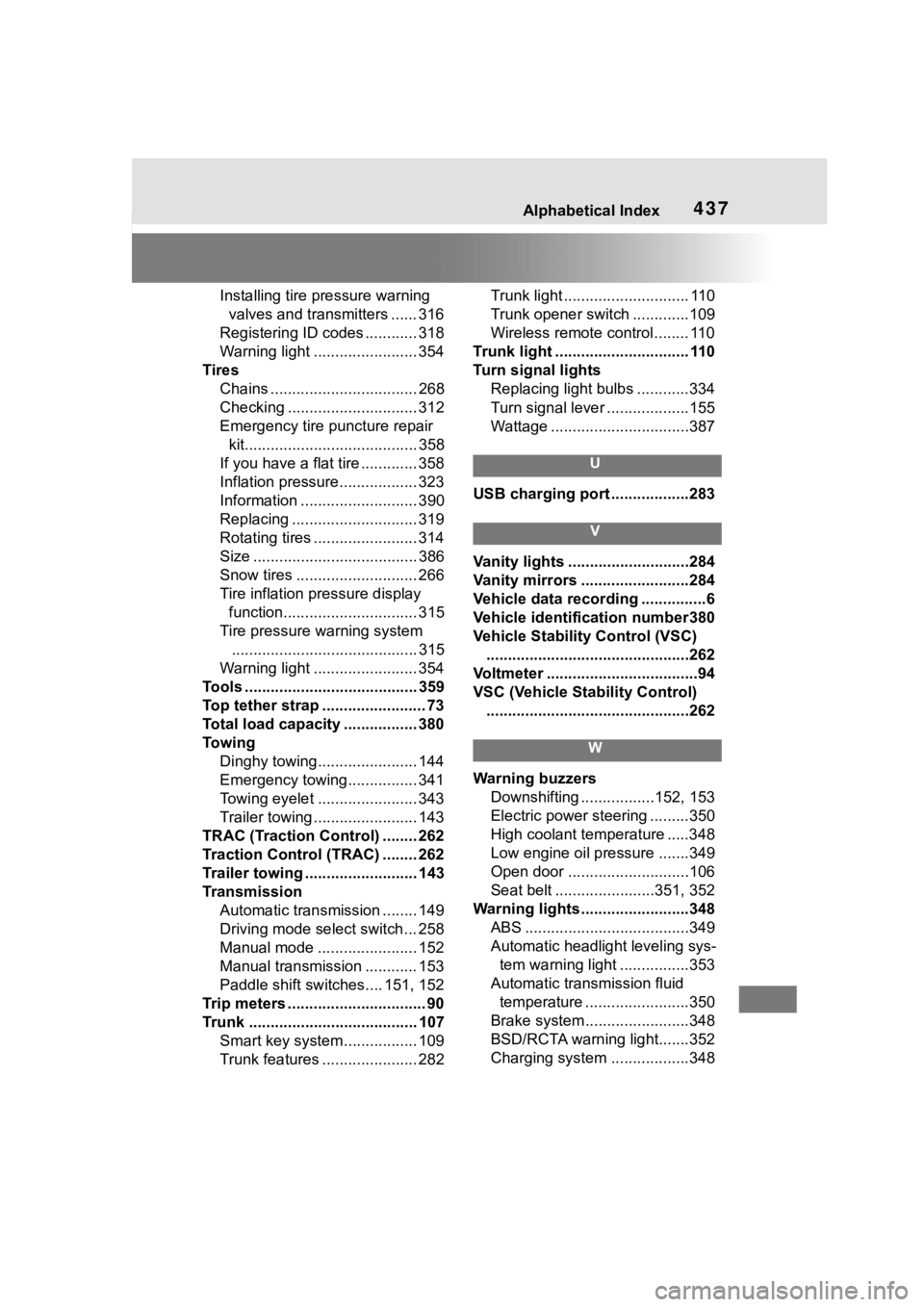
437Alphabetical Index
Installing tire pressure warning valves and transmitters ...... 316
Registering ID codes ............ 318
Warning light ........................ 354
Tires Chains .................................. 268
Checking .............................. 312
Emergency tire puncture repair kit........................................ 358
If you have a flat tire ............. 358
Inflation pressure.................. 323
Information ........................... 390
Replacing ............................. 319
Rotating tires ........................ 314
Size ...................................... 386
Snow tires ............................ 266
Tire inflation pressure display function............................... 315
Tire pressure warning system ........................................... 315
Warning light ........................ 354
Tools ........................................ 359
Top tether strap ........................ 73
Total load capacity ................. 380
To w i n g Dinghy towing....................... 144
Emergency towing................ 341
Towing eyelet ....................... 343
Trailer towing ........................ 143
TRAC (Traction Control) ........ 262
Traction Control (TRAC) ........ 262
Trailer towing .......................... 143
Transmission Automatic transmission ........ 149
Driving mode select switch... 258
Manual mode ....................... 152
Manual transmission ............ 153
Paddle shift switches.... 151, 152
Trip meters ................................ 90
Trunk ....................................... 107 Smart key system................. 109
Trunk features ...................... 282 Trunk light ............................. 110
Trunk opener switch .............109
Wireless remote control........ 110
Trunk light ............................... 110
Turn signal lights Replacing light bulbs ............334
Turn signal lever ...................155
Wattage ................................387
U
USB charging port ..................283
V
Vanity lights ............................284
Vanity mirrors .........................284
Vehicle data recording ...............6
Vehicle identification number380
Vehicle Stability Control (VSC)...............................................262
Voltmeter ...................................94
VSC (Vehicle Stability Control) ...............................................262
W
Warning buzzers Downshifting .................152, 153
Electric power steering .........350
High coolant temperature .....348
Low engine oil pressure .......349
Open door ............................106
Seat belt .......................351, 352
Warning lights .........................348 ABS ......................................349
Automatic headlight leveling sys-tem warning light ................353
Automatic transmission fluid temperature ........................350
Brake system ........................348
BSD/RCTA warning light.......352
Charging system ..................348